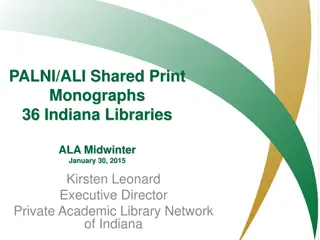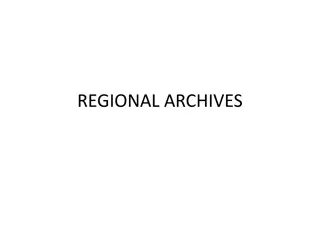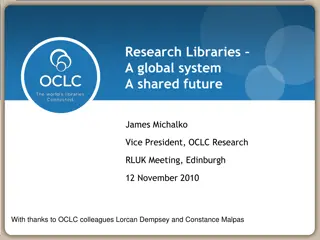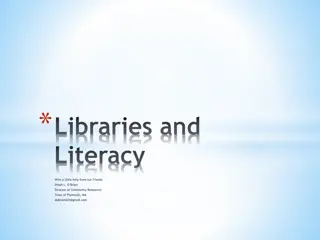Impact of Archives Existing in Libraries: Collaboration and Power Dynamics
Archives existing within libraries bring about both collaboration opportunities and challenges due to imbalanced power dynamics. Research explores corporate identity, relationships, and user experiences in such setups. Methodology includes case studies, interviews, and surveys. Insights reveal collaboration benefits and feelings of isolation. Perceived impact highlights decisions affecting roles within the combined library-archive structure.
Download Presentation

Please find below an Image/Link to download the presentation.
The content on the website is provided AS IS for your information and personal use only. It may not be sold, licensed, or shared on other websites without obtaining consent from the author.If you encounter any issues during the download, it is possible that the publisher has removed the file from their server.
You are allowed to download the files provided on this website for personal or commercial use, subject to the condition that they are used lawfully. All files are the property of their respective owners.
The content on the website is provided AS IS for your information and personal use only. It may not be sold, licensed, or shared on other websites without obtaining consent from the author.
E N D
Presentation Transcript
Empowered to Collaborate, or Challenged by Imbalanced Power: The Impact of Archives Existing in Libraries ASHLEY TODD-DIAZ 2018 SAA RESEARCH FORUM WASHINGTON D.C. AUGUST 14, 2018
Background Libraries and archives have existed separately. Many archives in the US exist organizationally within libraries. Within the last decade, research on the convergence between libraries and archives has increased.
Research focuses 1. Corporate identity of an archives within a library 2. Tensions surrounding parent-child relationships 3. The impact of corporate identity and placement of archives within libraries on the user experience
Methodology Collective case study (5 institutions) that includes three investigations: Document analysis Semi-structured interviews with administrators Intercept survey with users Comparison across data sources, as well as within organizations
Emergent Insights Collaboration and/or Challenges
Collaboration An army of three is not very strong. We have 15 faculty; so a library of 15 is stronger than an army of three (Dean, Inst. 4). I think there are a lot of natural partnerships that it just makes it much easier for them to be in the same big unit (AUL, Inst. 3). I think there s a bit more of a sense of camaraderie and being a part of larger library issues because we are in the same building (Head of SpecColl, Inst. 1).
So close, but so far away I guess a lot of what we do is separate from the library and it s downstairs (Archivist_2, Inst. 2). I m not an outsider, but I feel like I m watching [the library] from a distance (Head of SpecColl, Inst. 4).
Perceived impact I made a really serious mistake once we decided to make [a new archivist] position a librarian. I sent out a message to the staff and said we made this decision because this was somebody who is going to be operating with an impact across the whole library system, and so we felt it was appropriate for this person to be a librarian (AUL, Inst. 1).
Are we on the same team? There is still this sense of privilege about [special collections]. It is very different work from what most people do; we say no a lot (Head of SpecColl, Inst. 1). [Staff meetings let us] hear what s going on in the library because we re closed off to a lot of that, and we re on a different email thread from them (Archivist_2, Int. 2). When we consolidated academic support into our division, it made sense to physically separate [SpecColl] from the library because it was a different population using the archives (Dean, Inst. 4).
Implications Behavioral Theory of the Firm (Cyert and March, 1963/2010) Proximity does not guarantee collaboration or alignment of goals. Organizational culture cultivates the potential for collaboration or conflict. Users are focused on convenience and how an archives relates to them. 64% of users note the need for the materials is more important than location. Cyert, R., & March, J. G. (2010). A behavioral theory of the firm. New Jersey: Prentice Hall, Inc. (Original work published 1963.)
Thank you! Ashley Todd-Diaz Head of Special Collections and University Archives Towson University atodddiaz@towson.edu























